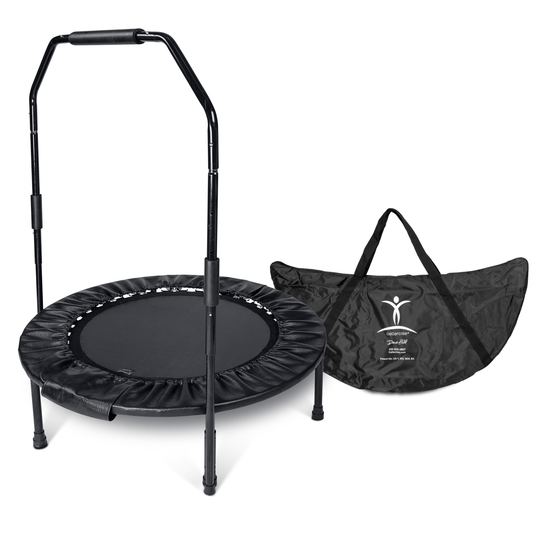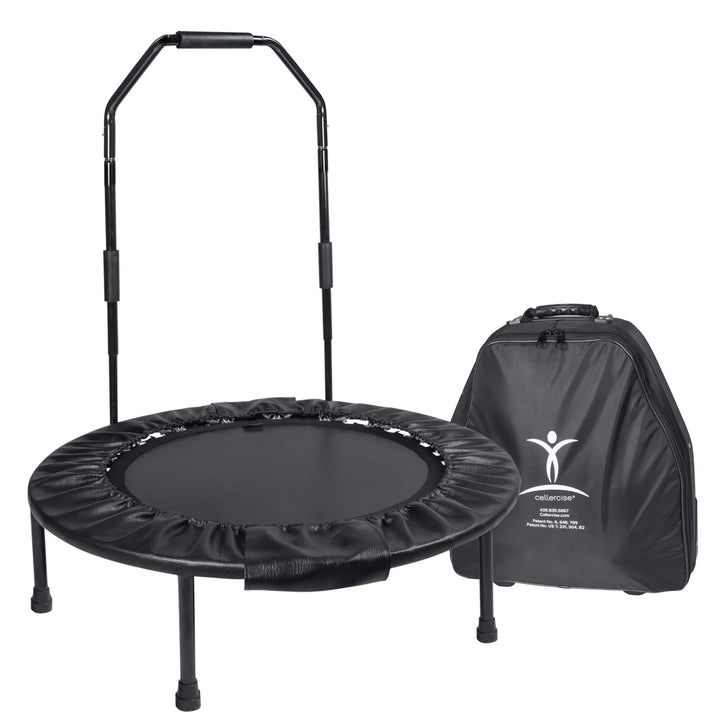Is Rebounding More Effective Exercise Than Running?
Disclaimer: This Blog/Web Site is made available by the publisher for educational purposes only as well as to give general information & understanding regarding the industry. It is not to be used as specific medical advice or to replace consulting with your doctor. You should always consult with your doctor. By using this Blog / Web Site you understand that this Blog/Web Site should not be used as a substitute for medical advice from a licensed professional. For our full disclaimer, please read: Cellercise® Disclaimer
If you’re looking for a great way to add cardio exercise to your workout regimen but dread the thought of running, rebounding could be the perfect solution for you. You don’t need to feel bad if you have a disdain for running; it is not for everyone and can be incredibly stressful if you don’t enjoy doing it. Running can be effective exercise, but it’s important to enjoy your workouts if you want to stick with them long enough to see the results you want.
You might wonder how rebounding could be an effective exercise at all, let alone compete with running in terms of overall results for the average person. The truth might surprise you. Depending on your personal fitness goals, a mini trampoline could be a more effective investment in your overall wellness than a pair of high-end running shoes, and you will probably have more fun, too.
Rebounding and Running for Fitness
Running is a great form of exercise, but it requires you to meet several criteria for it to be as effective as you imagine. First, you need to have the right equipment. Not just any running shoes will do; you should invest in a pair of running shoes fitted to your foot arches. You also need a good place to run. This may not be an issue for some people, but, for others living in densely populated cities, it may seem like more of a struggle to find a good route.
Running also takes time to become an effective form of exercise. You should not expect to lace up your shoes and start running and then clear several miles on your first attempt unless you’re already in relatively good shape. It may take time for you to build up your endurance enough to handle longer-distance runs. David Hall, the owner of Cellercise®, reminds readers that running is great exercise, but there is an impact. Repeated jarring impact causes many detriments throughout the body. Running is not without risks; falling on hard surfaces can cause injuries, running can cause fallen uterus, lower back issues, joint problems, knee issues, and many other health problems. Cellerciser® allows you to “jog” and get the circulation going without the impact. “Weightless” jogging on a Cellerciser® is a very intense aerobic exercise without the detriments that running usually entails.
Rebounding offers a much gentler introduction to aerobic exercise with minimal strain. While running is high-impact exercise due to the force of your feet hitting the ground over and over, rebounding is low impact exercise that puts minimal strain on the joints. If you’re just starting to develop an exercise routine, rebounding comes with a dramatically lower risk of injury compared to running.
Rebounding May Offer Better Results, and It’s Easier Than Running
It’s no secret that running is difficult exercise, especially for people who are just starting to develop better exercise habits. It can take a long time before it feels easier and before new runners start seeing results from their efforts. By comparison, rebounding is very easy, can be done in the comfort of one’s own home, and has very minimal risks compared to running. It’s a full body workout for people of all athletic abilities, shapes, and sizes.
While it may seem natural to assume that the more intense exercise will offer the best results, this may not be entirely true in the case of rebounding versus running. A new study funded by ACE Fitness seems to indicate that rebounding may offer the same health benefits as running, but it won’t feel as hard to do. The study covered 24 male and female college students who engaged in a series of tests to measure cardiovascular health over time, checking both heart rate and VO2max, a commonly used metric for measuring physical fitness. The study concluded that both rebounding and running encouraged heart rates and VO2max levels consistent with strong cardiovascular fitness improvement.
Running may seem straightforward at first, but it takes time to reach an acceptable pace and heart rate for the exercise to be effective. It may take weeks or even months of daily running before a person feels comfortable with running as part of a daily exercise routine, whereas rebounding is easy to start and can provide noticeable results in about as much time as running could.
Mentality Is a Big Factor in Exercise Efficacy
If an exercise feels like a chore or is otherwise unenjoyable, it is harder for a person to stick with that exercise as part of an everyday exercise routine. On the other hand, if an exercise is fun and enjoyable, it is much easier for a person to engage in that activity willingly on a regular basis. Rebounding is fun, pure and simple. Virtually everyone who invests in mini trampolines reports how much fun they have with them, even if they only use them for a few minutes each day. What’s important is that they keep using them, and they eventually see surprising results they may not have initially expected.
Rebounding is a unique exercise in that it is a full body working for people of all builds and athletic ability. Rebounding can effectively work more muscle groups and provide just as much of a cardio workout as running, but it is typically more enjoyable than running to a large majority of people unaccustomed to daily running.
When an activity is fun, it is easier to keep doing the activity for longer. The ACE Fitness study indicated that the study participants had more fun while rebounding and therefore perceived less exertion. This means your rebounding workout will be easier to complete than a run and provide you with just as much, if not more, measurable benefit when it comes to burning calories.
Adding Rebounding to Your Workout Regimen
If you want to lose weight or simply get into better shape, running may seem like the optimal choice, but if you don’t enjoy it, you probably won’t see as much of a return for your efforts as you expect. By comparison, rebounding can be incredibly effective while feeling less difficult. This in turn encourages you to stick with it as part of your daily exercise routine.
As you consider the choice between a mini trampoline and a pair of running shoes, think carefully about what seems more enjoyable to you. If you dread the thought of running every day, then pass on the shoes and pick up a mini trampoline to start burning calories in a more enjoyable way. Keep in mind that the contents of this article are not medical advice, nor does this content intend to help treat any specific medical issue. Always speak with your doctor before starting any kind of new exercise.
NOTE: Remember to always consult with your doctor or health professional before starting new exercise routines.
Get Your Cellerciser® and start rebounding today!














